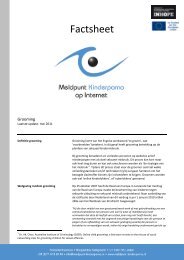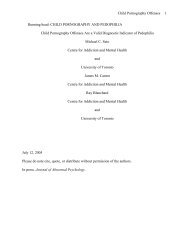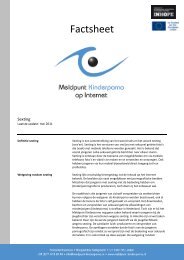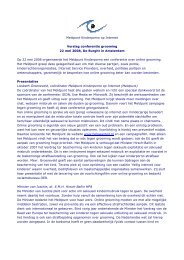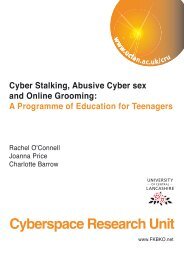sexual exploitation of children over the internet - Meldpunt ...
sexual exploitation of children over the internet - Meldpunt ...
sexual exploitation of children over the internet - Meldpunt ...
Create successful ePaper yourself
Turn your PDF publications into a flip-book with our unique Google optimized e-Paper software.
eviews are as effective and aggressive as <strong>the</strong>y can be. For example, at <strong>the</strong> June hearing,<strong>the</strong> social networking websites, particularly, MySpace, were asked if <strong>the</strong>y screened <strong>the</strong>irsites for registered sex <strong>of</strong>fenders. At that time, none <strong>of</strong> <strong>the</strong> social networking websitesconducted any type <strong>of</strong> screening for sex <strong>of</strong>fenders on <strong>the</strong>ir websites. Now, almost sixmonths later, MySpace announced on December 5, 2006 that it was working to develop atechnology that will allow it to block convicted sex <strong>of</strong>fenders from accessing MySpace.As <strong>the</strong> technology has yet to be implemented, its effectiveness remains uncertain. Evenso, it seems that <strong>the</strong> websites primarily rely on <strong>the</strong>ir users to ferret out and bringinappropriate content to <strong>the</strong>ir attention. As Facebook testified, <strong>the</strong>y believe userreporting works best because Facebook users are best able to recognize individuals whodo not belong in <strong>the</strong>ir school communities and do not tolerate behavior or content thatdoes not meet <strong>the</strong> community’s standards. While Facebook is unique in that its userswebpages are organized according to high school, college, or regional communities andonly available to o<strong>the</strong>r users within <strong>the</strong> same community, Xanga also found that itsreporting or “flagging” system has proved reliable in identifying child pornography oro<strong>the</strong>r inappropriate content.Despite <strong>the</strong>se safeguards, <strong>children</strong>’s webpages on social networking websites are stillvulnerable to child predators as <strong>the</strong> success <strong>of</strong> <strong>the</strong> safeguards largely depends on a child’sability to recognize a dangerous situation, and report it, or to affirmatively activate <strong>the</strong>safeguards and privacy settings. The search functions <strong>of</strong> a website also pose a risk to<strong>children</strong>’s safety online. While Xanga and Facebook do not permit its members to searcho<strong>the</strong>r member’s webpages for personal characteristics, such as height, sex, or interests,MySpace users can search member pr<strong>of</strong>iles for a variety <strong>of</strong> factors including sex, age,marital status, body type, and interests. Though <strong>the</strong> webpages <strong>of</strong> MySpace users who areunder age 16 have a default privacy setting and, even if that setting is deactivated, <strong>the</strong>yare available only to o<strong>the</strong>r users under <strong>the</strong> age <strong>of</strong> 18, child users are still at some riskbecause <strong>the</strong> system can easily be manipulated by users who lie about <strong>the</strong>ir age. 21 It takesonly minutes to search for and find <strong>children</strong> who are under 16-years-old on MySpace.For example, Committee staff did a search on MySpace for persons 4’11” or shorter.This simple search unc<strong>over</strong>ed numerous underage users who accurately stated <strong>the</strong>irheight in <strong>the</strong>ir pr<strong>of</strong>ile, but who <strong>over</strong>-reported <strong>the</strong>ir age, a common tactic by underageusers to evade <strong>the</strong> MySpace age restrictions.Although all <strong>the</strong> social networking sites testified that <strong>the</strong>y have been unable todevelop a viable age verification system to weed out underage users, it appears that withsome basic search techniques and development <strong>of</strong> more refined search algorithms, <strong>the</strong>secompanies should be able to detect underage users and those violating <strong>the</strong>ir Terms <strong>of</strong> Usein a more effective fashion. The lack <strong>of</strong> effective methods for protecting <strong>the</strong> adolescentmembership <strong>of</strong> <strong>the</strong>se websites, or limiting <strong>the</strong> websites to adults only, necessarily meansthat <strong>children</strong> are placed at risk <strong>of</strong> exposure to child predators. Social networkingwebsites could require a verifiable credit card in order to confirm <strong>the</strong> age <strong>of</strong> <strong>the</strong> user,however, credit card companies have resisted allowing <strong>the</strong>ir systems and databases to beused for such confirmation without a purchase first taking place.21 MySpace does not permit users who under <strong>the</strong> age <strong>of</strong> 18-years-old to specifically browse for users whoare 16-years-old or younger. In addition, adults can never browse for users who are 18-years-old or under.24





